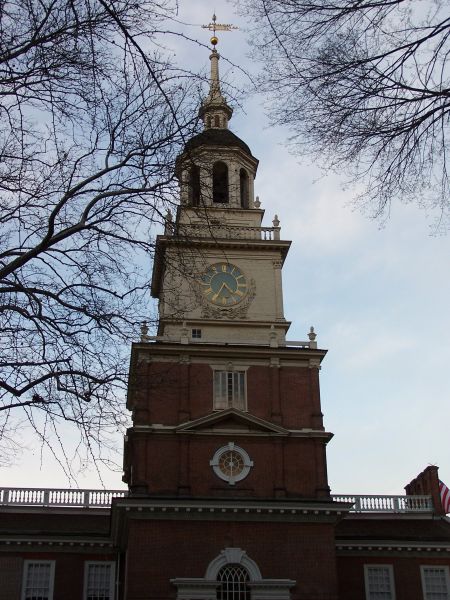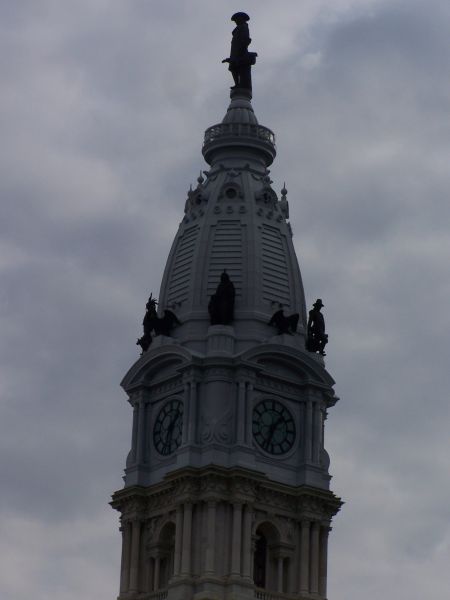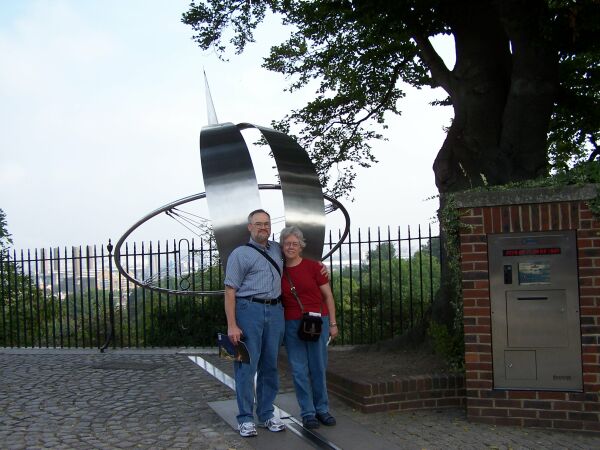Background Information
With apologies to Stephen Hawking, this cache will present a brief history of time, then require you to do some online research to solve the puzzle.
From the American Revolution until well after the Civil War, time in the U.S. was determined locally based on the elevation of the sun. When the sun was at maximum elevation, a person at any given location knew that it was noon. If one chose a reference point such as New York City, for each degree west, the time was four minutes behind the reference point. Therefore, in a city ten degrees west of New York, noon occurred 40 minutes later relative to New York.
Regional citizens were kept informed of the local time by tall towers containing clocks such as the one at Independence Hall or the Philadelphia City Hall


With the expansion of, and improvement in reliability of the railroads, a more structured and uniform method of time keeping became essential, partly for convenience and partly for safety. Trains often traveled in both directions on single tracks and time slots were allocated for travel in each direction along specific sections of track. At a certain time, a westbound train would be scheduled to divert onto a siding to allow an eastbound train to pass or vice versa. If the engineers on both trains didn't have a good coordinated time system, head-on collisions could result.
Therefore, the managements of the major railroads met in St Louis, Missouri and established time zones for the North American continent. The time system resulting from this agreement was known as "Railroad Time". Civil governments and individuals often ignored this system, continuing to maintain local time. The city of Detroit, Michigan was one such "time maverick", using several different times between 1899 and 1916.
Finally, the U.S. Government in Washington, D.C. passed a law that established "standard" time zones across the continental U.S. and the time zone system with which we are familiar today became commonplace.
To solve for latitude:
Find the date of the "Day with Two Noons" and also the year in which the U.S. officially adopted "Standard time zones". Subtract the older year from the newer year and make a note of the result. Then subtract the first digit of the day of the month on which the two noons occurred from the second digit of the same date. Add the result to the difference of years. This will yield the degree portion of the latitude of the location of the final hide. (A)
Determine how many different time systems Detroit used between 1899 and 1916. This number represents (B) and is the first digit of the minutes of latitude.
Find an online copy of the 1883 version of the Crums Atlas Time zone map, updated to 1866. (Make sure you're viewing a map with one time zone shown to the east of Eastern Time). Based on this map, how many time zones did the railroads establish for the continental U.S. and Canada? This is the value of (C)
On the same Crums Atlas map above, what was the degree of longitude on which the time for the westernmost time zone was centered? Add 728 to obtain (D) which should be a 3 digit number.
The latitude of this cache is N A BC.D minus 0.035 (to correct for new location 06/20/17)
To solve for Longitude:
Find the year in which "Railroad time" was established, and subtract 1800 (the century) from the year, which should result in a two digit number. Add one to this number to determine the degree portion of the longitude of the final coordinates. (E)
Locate a virtual Geocache listing associated with the Washington National Cathedral in Washington, D.C. The 1st digit of the decimal minutes of the longitude of this cache provides (F).
Search for a virtual cache related to the St. Louis Arch. Divide the degrees of longitude (only the degrees, ignore minutes) by 10 to derive (G).
Look up Geocache GCG0HC. Note where it is physically located. Using the online maps of the Railroad time zones and standard time zones, and including local time as one format, how many time formats has the town in which this cache is located experienced since 1885 (ignoring Daylight savings time). Add 2. The resulting number represents (H) which is the first digit in the decimal minutes portion of the coordinates.
Including the territorial regions of the U.S., how many time zones are used by the United States?
Use "https://www.countries-ofthe-world.com/world-time-zones.html" as your source for this data. Subtract 7. Let this result represent (I)
Examine the cache page for GC1GAWJ which is located in the Mountain time zone. From the description and photos associated with the cache page, determine what team assisted the owner with placement of this cache. If you don't already know the answer, you need to figure out how many people make up the team that assisted. The information is available if you dig deep enough (don't count the dog or cats). This number is the final digit (J) of the coordinates.
The longitude of the cache is W 0E FG.HIJ minus 0.008 (to correct for the new location 06/20/17)
As a final note, the base of all the times zones is at Greenwich Observatory in London where it's possible to stand in both hemispheres at the same time as we did in 2005.

You can check your answers for this puzzle on GeoChecker.com.
.
We took the readings for this cache location on a cloudy day with full leaf cover and averaged 70 readings. The GPS was showing an accuracy of 13.8 feet. There should be routes available to get to the cache with dry feet most of the year if you hunt for alternatives long enough. In the spring or other wet periods, you may need to avoid some puddles on the trails or possibly tiptoe through some shallow water and or slimy mud.
This park is fairly heavily used, so muggles may be a factor. In the fall, there are cross country events in the park which use the trails near the cache so you may have to avoid hurried harriers.
Leashed dogs are welcome in the park, cleanup is required. Watch your step, however, because not all dog owners behave responsibly.
You may encounter thorns near the cache, but the final hide should be thorn free unless this suffers from "cache creep" issues.
Mosquitoes will be a significant issue in the warm season, come prepared. There are acres of standing water in the park except during droughts.
There IS poison ivy along the trail and near the cache. We placed the cache wearing shorts and sneakers, but wouldn’t recommend sandals or open toed shoes. It is possible (but tricky) to get to the actual hide without contacting poison ivy as long as you’re aware and careful.
Comments about the initial contents:
There are items here from many time zones. We purchased a variety of items from a local Fair Trade store a while back. However, we never got that done and the store went out of business. There are items from South America and Africa at the least. Some of them have concepts that date back to the times of the Mayans, some were elephant dung in Africa at one time (kids should love that!) We also placed items from a different time in U.S. History when Route 66 was "The Mother Road" and the main way to get across the continent, items that tell time, items that can grow thyme, and items from different times in our team's caching history. In addition, there are several items that we hope children will enjoy without worrying about the time factor.
Congratulations to dotdotdash for first to find honors, followed very closely by the Allen Cachers
